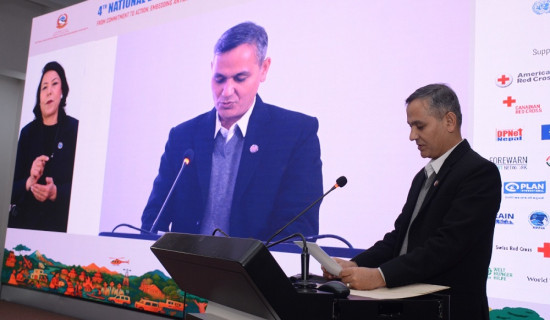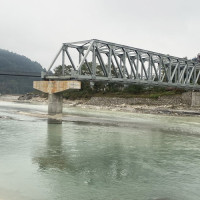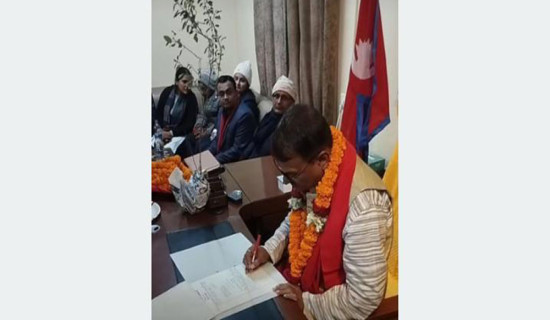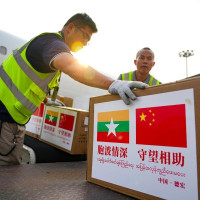- Monday, 22 December 2025
Rebuild Ilam's Ravaged Roads Soon
On the night of October 4, 2025, heavy rainfall struck various parts of Ilam district, including Ilam Municipality, Suryodaya Municipality, Deumai Municipality, Mai Municipality, and several rural municipalities, triggering massive floods and landslides. The disaster caused extensive damage to life, property, and road networks, leaving the Mechi Highway blocked and transportation across eastern Nepal in disarray. For locals, daily life has become increasingly difficult.
The devastating rainfall and subsequent landslide that night completely obstructed the Rajduwali–Khadka section of Ilam Municipality - 9. The landslide buried three bends of the road, causing it to collapse entirely. Commuters now risk their safety, walking nearly half an hour on foot to cross the affected section. With transportation paralysed, the movement of people and goods between Jhapa, Ilam, Panchthar, and Taplejung has been severely disrupted.
Geo-engineering study
Over the years, authorities have invested considerable financial and human resources to maintain this section, but with little success. The expected outcomes have not been materialised. Neither the state, local governments, nor the technical agencies have addressed the root causes of the problem. One must ask: Was a proper geo-engineering study ever conducted in the Rajduwali area? Is there an underground spring or runoff contributing to the slides? Could leakage from the nearby Puwakhola hydropower pipeline be a factor? Has a drainage master plan been developed?
The area is geologically unstable, lacking a proper drainage system, which has made landslides a recurring hazard. Consequently, this section of the Mechi Highway continues to suffer under the guise of periodic maintenance and reconstruction, while the public bears the pain. Residents of Panchthar, Taplejung, and Ilam are enduring this hardship together. The Mechi Highway serves as the lifeline of all four districts in the erstwhile Mechi Zone Jhapa, Ilam, Panchthar, and Taplejung. Given its importance, shouldn’t the Chief District Officers, security agencies, and technical teams from all four districts coordinate and act collectively?
When the government declared Ilam a “crisis-hit area” following the recent floods and landslides, what share of responsibility was assumed by the federal government, local governments, and the geo-engineering sector respectively? Support and relief efforts from the state, local governments, social organisations, and individuals are ongoing. Yet, the road itself continues to suffer a silent victim of human negligence, political corruption, and flawed contracting practices. The pressing question remains: who will heal these environmental and infrastructural wounds, and when?
Ilam, despite its natural wealth, has endured back-to-back crises first the COVID-19 pandemic, and now this wave of natural disasters. Roads, settlements, and public infrastructure have been devastated, recreating both physical and emotional isolation among communities. Just as Panchthar suffered last year, Ilam now bears the same fate. For the foreseeable future, the district’s development will likely remain confined to patchwork reconstruction and makeshift solutions.
The harrowing scenes of broken bridges, collapsed roads, displaced settlements, and disrupted lives may have been briefly observed by Kathmandu officials during helicopter inspections or short field visits. But such gestures are insufficient. The state’s relief has yet to be tangibly felt in Ilam. Despite producing some of the nation’s most prominent political leaders, the district has long been deprived of genuine, people-centered development particularly in education and health. Frequent political changes have brought little progress, and Ilam still awaits leadership capable of addressing both its natural and political wounds.
This disaster has underscored Ilam’s fragile geography and offered a stark reminder of where and how future infrastructure must be built. Roads like Birtamod–Fikkal–Ilam are as essential as Birtamod–Belase–Golakharka–Ilam. Similarly, the Simal Golai–Tilkeni, Belase–Ilam, and Belase–Jitpur–Manglabare–Rakse (or Ranke) routes are equally vital. These must be blacktopped without delay, with robust bridges constructed and maintained for long-term resilience.
Road collapses in Ilam are nothing new. There have been numerous efforts, discussions, and suggestions in the past. Alternative routes should be naturally open and freely accessible, allowing vehicles to take whichever route is safest and most efficient. Two alternative corridors Jhapa–Belase–Ilam and Simal Golai–Jogmai–Ilam were identified, but both have now suffered damage. Floods swept away the Bailey bridges over the Puwakhola and Maijogmai rivers, while the concrete bridge over the Maikhola at Belase (along the Kechana–Kanchanjunga Corridor) was destroyed.
The lesson is clear: infrastructure must be built in geologically suitable locations, with strength and longevity as guiding principles. Roads should not be built on a whim to serve political interests, nor should local or technical agencies act without considering long-term impacts. Infrastructure must be planned on the basis of need, safety, and sustainability with regular monitoring, maintenance, and evaluation. Soil-retaining and water-absorbing structures should be constructed near rivers, along with improved drainage systems, retaining and gabion walls, forest conservation, and reforestation. Early warning systems and disaster preparedness programmes must be integrated into local planning.
Restoring transportation system
As a temporary measure, transportation during the dry season could be rerouted via Simal Golai–Jogmai–Ilam, using Hume pipes across the Jogmai River to restore connectivity. Geo-engineering experts have also proposed several short- and long-term interventions. Some of them include building strong retaining structures at the Rajduwali landslide base and constructing cut-off drains, installing gabion baskets or box culverts to divert runoff water into nearby rivers and setting up hand ropes for pedestrian crossings and imposing weight limits on heavy vehicles.
Likewise, flights to Sukilumba Airport could be made twice-weekly Ilam–Kathmandu flights during suitable weather, with subsidized fares and possible Bhadrpur–Ilam connections. Permanently realigning or relocating the vulnerable Rajduwali section and implementing a comprehensive drainage master plan is also essential.
When politics infiltrates road or bridge construction, it breeds unhealthy competition, corruption, and collusion between contractors and politicians. The people suffer, the land bears unnecessary pressure, and superficial “development” replaces genuine progress. For Ilam’s long-term connectivity and sustainable growth, the Simal Golai–Ilam and Belase–Ilam sections must be strengthened and blacktopped, with durable bridges constructed over the Jogmai and Mai rivers. All development activities must undergo regular evaluation and monitoring, while citizens remain vigilant and informed.
(The author is a Reader at Ilam Campus.)





-square-thumb.jpg)










